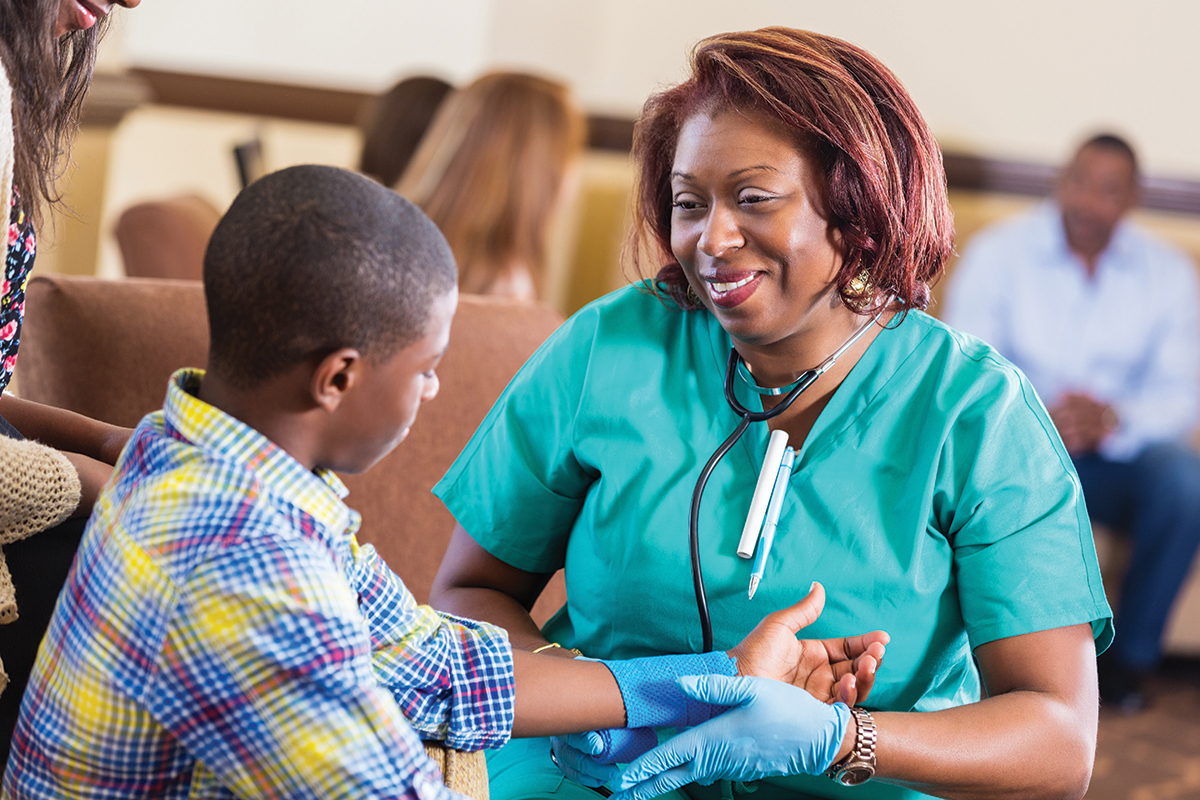From Concern to Collaboration

WilmU’s College of Social and Behavioral Sciences brings together expertise from three WilmU colleges to create the new graduate certificate in Trauma and Resilience.
Early exposure to abuse, neglect, or family dysfunction has a lasting impact on a child’s physical, mental and social health. Traumatic experiences later in life are all but inevitable. Even entire communities can be traumatized by poverty, violence and discrimination.
Professionals in many fields, including human services, education and healthcare, have the potential to guide victims toward recovery. Wilmington University’s new Trauma and Resilience certificate program aims to build that potential into ability. The graduate-level certificate, launched this summer by the College of Social and Behavioral Sciences, offers the evidence-based training necessary to promote preventive health, healing and growth.
“No matter where you are, you’ll find people who are experiencing the effects of trauma,” says Dr. Rebecca Ghabour, who chairs the college’s Psychology and Organizational Dynamics programs. “Our Trauma and Resilience certificate is designed to educate the people who are out there doing the work of helping.”
Since trauma and the resulting responses cut across the entire span of human lives, the College of Social and Behavioral Sciences sought the collaboration of faculty members from WilmU’s colleges of Education and Health Professions in creating the Trauma and Resilience certificate. The curriculum for the five-course, 15-credit program includes coursework options in classroom teaching, educational counseling and nurse leadership, as well as psychology, administration of human services, and applied family science.
“We wanted the certificate to be able to educate everyone in the social safety net,” says Dr. Debra Berke, director of Psychology programs and the Center for Prevention Science. “Everyone who comes in contact with a trauma victim’s life is key, and they can all help.”
Hidden in Plain Sight
The idea that early trauma can shape the course of a person’s life isn’t particularly revolutionary, but research surveying just how often early trauma occurs has attracted significant attention in the two decades since its publication.
The numbers emerged from an unexpected source. Researchers at health care network Kaiser Permanente’s weight-loss clinic in San Diego were seeing about half of the clinic’s patients quit the program, even though nearly all of those who dropped out had lost weight.
Interviewing 286 of the dropout patients, Dr. Vincent Felitti, then-director of Kaiser Permanente’s Department of Preventive Medicine, discovered that the majority had suffered sexual abuse as children. Had their weight gain been a method of coping with the emotional after-effects?
To find out, Dr. Felitti and Dr. Robert Anda of the Centers for Disease Control and Prevention surveyed 17,337 Kaiser Permanente patients about adverse childhood experiences, or ACEs. In addition to sexual and emotional abuse, these traumas included physical and emotional neglect, mental illness, substance abuse, domestic violence, divorce, maternal depression, homelessness and incarceration.
The resulting study, published in the American Journal of Preventive Medicine in 1998, estimated that about two-thirds of all adults have suffered at least one ACE. Forty percent of the survey’s respondents reported two or more, and 12.6 percent had experienced four or more.
An examination of the respondents’ medical and social histories led Drs. Felitti and Anda to suggest that ACEs can disrupt the development of children’s brains, which is likely to impair their social, emotional and cognitive abilities. These deficits may lead to risky health behaviors, which in turn might trigger disease, disability, and/or social problems, and ultimately an early death.
In 2017, researchers Dr. Wendy Ellis and Dr. William Dietz of George Washington University complemented the study’s findings with a look at the impact of adverse community environments. These environments — in which populations are affected by poverty, discrimination, community disruption, a lack of opportunity, economic mobility or social capital, poor housing quality and affordability, and violence — often contribute to and then compound adverse childhood experiences, a health and social hazard the researchers call “a pair of ACEs.”
Cultivating a Curriculum
The George Washington University study proposes a solution through “building community resilience” to increase public engagement and improve the quality of life in a community. This process, the researchers write, depends on interdisciplinary net-working, training, and partnership among healthcare providers, human service agencies, educators and other organizations.
“You can’t address social ills from just one angle,” explains WilmU’s Dr. Berke. “You have to approach them from all sides.”
That type of collaborative outreach fueled the Trauma and Resilience certificate. It also informed the College of Social and Behavioral Sciences’ previous trauma-related educational initiatives, which helped to lay the foundation for the new program.
The undergraduate certificate in Trauma-Informed Approaches, launched in 2016, “is one of our fastest-growing programs, in terms of enrollment,” says Dr. Ghabour. “We’ve seen it drawing interest from master’s students in Education and Health Professions as well,” which highlighted the demand for a graduate-level option.
The launch of WilmU’s Center for Prevention Science followed. Designed as a resource for community assistance, the center channels faculty members’ research and students’ hands-on coursework toward social and public health concerns. Most recently, Dr. Berke oversaw training for more than 450 Delaware Department of Labor employees from February through June on trauma awareness, the first of the four-stage continuum to becoming trauma informed. In addition, Dr. Ghabour presented workshops to the faculty and staff of Delaware elementary schools on how ACEs affect children’s learning behaviors and how identifying and responding to trauma’s impact can result in better outcomes, healing and resilience.
It’s a trend to which educators are increasingly attending. “We’re just opening the door on this topic, but over the last several years it’s gained more and more momentum,” says Al DiEmedio, director of Teacher Preparation programs in the College of Education, who notes that WilmU’s early childhood and elementary education courses now address trauma-informed teaching.
“We’ve learned that students bring a lot of needs into the classroom,” he says. “We want our future educators to be able to have a positive impact on these kids who’ve experienced violence or abuse.”
The College of Education introduced a new course, Building a Responsive Classroom (MED 6801), for the Trauma and Resilience certificate. It originated from an in-service training program for new teachers at New Castle’s Colonial School District.
“If we can prepare new educators with experiences that help them to look at situations with new eyes, that changes the dynamic for us,” says Melanie Barbas, lead teacher for classroom culture at Colonial, who co-taught the course there with WilmU assistant professor Tyler Wells and who brought it to WilmU for 2020’s Summer Block II. “And if they can develop positive relationships with their students, they can instill in them a sense of hope that their circumstances won’t necessarily de-fine the rest of their lives.”
Different Backgrounds, Common Goal
We recognize the responsibility and the need for this type of education in graduate nursing,” says Dr. Lisa Drews, RN and chair of the Master of Science in Nursing Leadership program at WilmU’s College of Health Professions. She recommended three graduate-level course options for the Trauma and Resilience certificate.
“Unfortunately, most people have some significant traumatic experiences that inform their health choices and their overall health,” she notes. “Nurses are out there, in every area of health care practice you can imagine, seeing those patients face-to-face, at every stage of their lives.
“It’s always been the heart of nursing to put the patient first,” says Dr. Drews. “Learning about trauma and resilience is nurse leaders gaining a new perspective, a new worldview, and incorporating new strategies to promote the health of the whole patient.”
To the benefit of those who are affected, it’s not just health care providers who will see them now. “We’re reaching out to different parts of the community,” says Dr. Ghabour. “When we talk about trauma in a proactive way, the response has been positive. People want to know more. We can share a common understanding. We’re really excited about that.”



